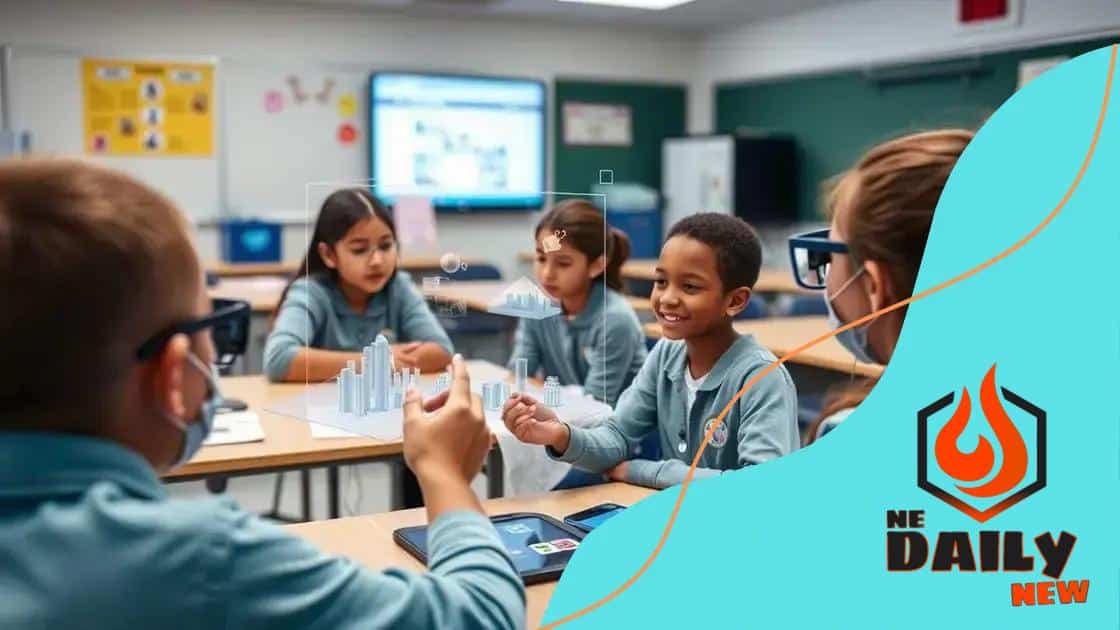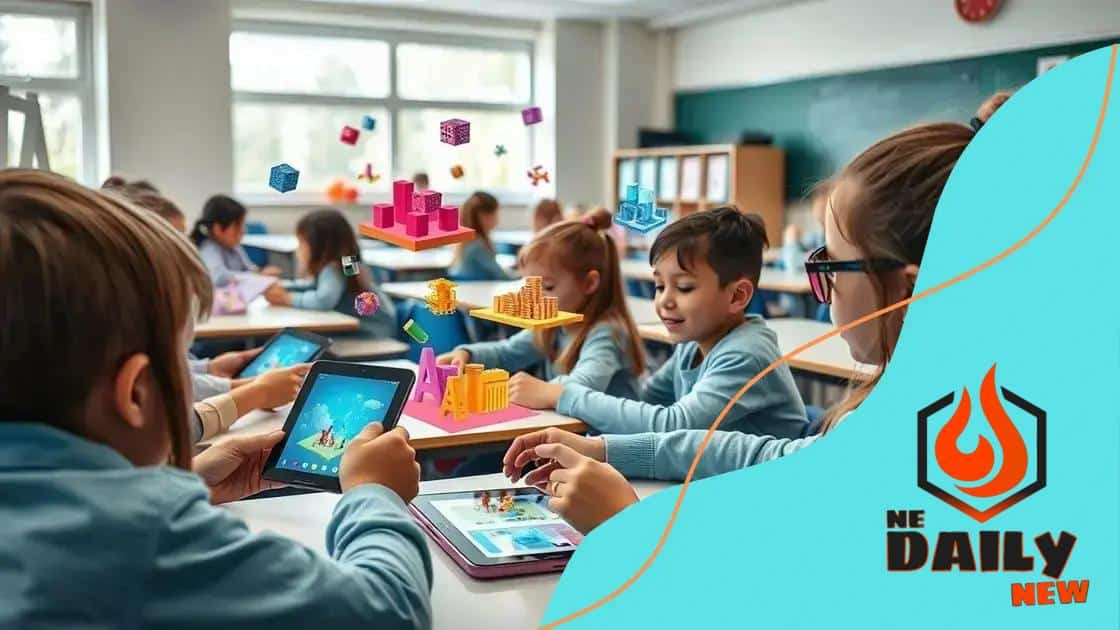How AR is being used for hands-on learning experiences

Augmented reality (AR) enhances education by providing interactive, personalized learning experiences that engage students and prepare them for future careers through immersive technology applications.
How AR is being used for hands-on learning experiences is transforming the educational landscape. Imagine interacting with 3D models and simulations during classes—sounds exciting, right? Let’s dive into how this technology is making learning more engaging.
Understanding the basics of augmented reality
Understanding augmented reality (AR) is essential for leveraging its benefits in education. AR blends digital information with the real world, enhancing the way we learn and interact with concepts. This creates immersive experiences that can significantly boost student engagement.
What is Augmented Reality?
AR involves overlaying digital content onto the physical environment. Unlike virtual reality, which creates a fully immersive digital world, AR enhances our reality with visual aids. For example, when students use AR apps, they can view 3D models of historical artifacts or biological organisms in their actual surroundings.
Key Components of AR
- Devices: Smartphones, tablets, and AR glasses are commonly used to access AR content.
- Software: Various applications enable interaction with AR, making learning more dynamic.
- Content: Engaging graphics, animations, and simulations are crucial for effective learning experiences.
This technology allows for hands-on learning that appeals to different learning styles, making complex subjects more digestible. For instance, students can use AR to dissect a virtual frog without the mess and ethical concerns of real dissection.
Furthermore, the ability to visualize information in 3D can help students understand spatial relationships and improve their retention of knowledge. The interactive nature of AR encourages exploration and inquiry, leading to a deeper understanding of subjects.
Applications of AR in Education
AR can be integrated into various subjects, including science, math, and history. In science, students can experiment with chemical reactions through AR simulations. In math, they can visualize geometric shapes in real space, helping them grasp abstract concepts. In history, AR can bring historical events to life, providing students with a rich context.
In summary, by understanding the basics of augmented reality, educators can create more engaging and effective learning experiences. The potential benefits are enormous, making it an exciting area for further exploration.
The impact of AR on education
The impact of augmented reality (AR) on education is profound. As students and teachers increasingly embrace AR technology, learning has transformed into an immersive experience. This technology enhances traditional teaching methods and engages students in unique ways.
Enhanced Learning Experiences
AR enables students to visualize complex concepts in real-time. For example, they can explore the solar system or dissect a virtual frog without leaving the classroom. Such experiences promote active learning, which helps students retain information.
Promoting Collaboration
In classrooms where AR is utilized, collaboration among students increases significantly. They can work together on AR projects and share their discoveries. This teamwork fosters communication and critical thinking skills. Here are some benefits of collaborative AR projects:
- Improved problem-solving: Students learn to solve challenges as a team.
- Enhanced creativity: Working together sparks creative ideas.
- Stronger relationships: Students build friendships through shared experiences.
Additionally, AR can create a more inclusive learning environment. For students with diverse learning needs, AR applications can be tailored to suit different styles of learning. This personalization enables all students to participate fully in their education.
Furthermore, teachers benefit from AR as well; they have access to a range of tools that can aid instruction. They can create engaging lessons that integrate AR content, making it easier for students to grasp challenging subjects.
Real-World Connections
Another important impact of AR is its ability to connect classroom learning with the real world. Students can go on virtual field trips, experiencing distant locations and cultures without leaving school. This connection enhances their understanding and appreciation of different perspectives.
Moreover, using AR in education prepares students for future careers where technology will be key. Familiarity with augmented reality tools will ensure they are ready for advancements in various fields, including healthcare, engineering, and design.
Practical applications of AR in classrooms

Practical applications of augmented reality (AR) in classrooms offer exciting ways to enhance education. By integrating AR technology, teachers can create immersive learning experiences that captivate students.
Interactive Learning Tools
AR can transform traditional learning tools into interactive experiences. For instance, students can use AR apps to view 3D models of organs while studying biology. This hands-on approach makes complex topics easier to understand.
Augmented Reality in STEM Education
One of the most significant applications of AR is in STEM (Science, Technology, Engineering, and Mathematics) education. Students can engage in virtual experiments, allowing them to manipulate variables and observe outcomes in real-time. This encourages critical thinking and enhances problem-solving skills. Here are some popular uses in STEM:
- Virtual labs: Students conduct experiments safely.
- 3D modeling: They visualize engineering designs in real-space.
- Simulation software: Programs help understand complex scientific concepts.
These tools not only make learning more engaging but also equip students with practical skills they will use in their future careers.
Enhancing Language Learning
AR can also enhance language learning by offering real-world context. For example, students can point their devices at objects around the classroom to receive translations and pronunciations. This method helps reinforce vocabulary in a fun way. Moreover, AR can immerse students in different cultures through virtual tours, making lessons more relevant and relatable.
Teachers can leverage AR to create customized learning paths. They can design lessons that adapt to each student’s pace, ensuring no one gets left behind. This personalized approach fosters a more inclusive classroom environment where all students can thrive.
Gamification of Learning
Incorporating game mechanics into lessons through AR turns learning into an exciting adventure. Students might participate in challenges that require solving problems or locating virtual items. These activities not only enhance learning but also motivate students to participate actively.
As AR continues to evolve, the practical applications in classrooms will expand. Integrating this technology into the curriculum has the potential to revolutionize education, making learning more engaging and impactful for students.
Case studies: Successful AR learning programs
Case studies of successful augmented reality (AR) learning programs demonstrate the powerful impact of this technology in education. Schools and institutions have embraced AR to enhance student engagement and improve learning outcomes.
AR in Science Education
One notable case study involves a high school that integrated AR into its biology curriculum. Students used AR applications to explore the human body in 3D. This interactive experience allowed them to visualize organs and systems, making complex concepts easier to understand. As a result, the students showed a 30% improvement in test scores.
History Comes Alive
Another example is a middle school that implemented an AR program in its history classes. By using an app, students could point their devices at historical sites and see reconstructions of events. This not only enhanced their understanding but also stimulated interest in the subject matter. Teachers noted that students were more enthusiastic and engaged in discussions.
Improving Math Skills
An elementary school adopted AR for its math lessons, allowing students to manipulate shapes and solve problems hands-on. By visualizing mathematical concepts through AR, students grasped challenging topics more quickly. The program resulted in a significant reduction in the number of students struggling with basic math principles.
Moreover, these case studies highlight how AR facilitates personalized learning. Educators can tailor AR experiences to meet individual student needs, ensuring that all learners make progress at their own pace. Schools have installed AR labs where students can access various resources and explore topics beyond the standard curriculum.
Engaging Special Needs Students
AR has also proven beneficial for students with special needs. A case study in a specialized institution showcased how AR tools helped students with autism improve their social skills. Through interactive AR scenarios, they practiced real-life conversations in a controlled environment, building confidence and communication abilities.
These examples illustrate the diverse applications of augmented reality in various educational settings. As more schools recognize the value of AR, the potential to transform learning continues to grow.
Future trends in AR for education
The future trends in augmented reality (AR) for education promise to revolutionize the learning experience. As AR technology advances, educational institutions are adapting to incorporate new methods that enhance teaching and learning.
Increased Accessibility
One of the main trends is the increased accessibility of AR tools. As technology becomes more affordable, more schools can implement AR programs. This allows a greater number of students to benefit from interactive and immersive learning experiences. With mobile devices being widely used, students will access AR applications anywhere, making learning flexible and adaptive.
Personalized Learning Experiences
Another growing trend is the personalization of learning through AR. Educators can tailor lessons to meet individual student needs. For example, AR applications can adapt to a student’s learning pace, providing customized challenges. This helps ensure that every student understands the material without feeling overwhelmed.
Integration with Other Technologies
AR is increasingly being integrated with other technologies. For instance, combining AR with virtual reality (VR) can create fully immersive environments—a practice known as Mixed Reality (MR). This fusion provides even richer educational experiences, allowing students to explore simulated environments while interacting with real-world objects.
Additionally, AR can be paired with artificial intelligence (AI) to create smart learning systems. These systems can analyze student performance and suggest appropriate AR content to reinforce concepts, making learning more effective and engaging.
Focus on Collaborative Learning
The trend towards collaborative learning is also set to grow. With AR, students can work together on projects, solving problems as a team. Collaborative AR applications encourage communication and teamwork among students. They can interact with virtual elements and each other in real-time, enhancing the learning experience.
Schools will likely see an increase in AR-based gamified learning, where friendly competition boosts engagement. By turning lessons into games, students become more motivated to participate and learn.
Real-World Applications
As AR technology develops, its applications in real-world scenarios will expand. Students will be able to gain hands-on experience in various fields, such as healthcare, engineering, and environmental science. For instance, medical students can practice surgeries in a risk-free AR environment, building their skills before working with real patients.
In summary, the future of augmented reality in education is bright. As technologies evolve, so do the opportunities for creating engaging, personalized, and effective learning experiences for students everywhere.
In conclusion, the future of augmented reality (AR) in education is exciting and full of potential. As schools integrate AR, students can enjoy interactive and personalized learning experiences. This technology not only boosts engagement but also prepares students for the demands of the modern world. With ongoing advancements, AR is set to transform how we teach and learn, opening doors to new possibilities for students everywhere.
FAQ – Frequently Asked Questions about AR in Education
How does augmented reality enhance student engagement?
Augmented reality captures students’ attention through interactive experiences, making learning fun and immersive.
What are the benefits of using AR in the classroom?
AR promotes hands-on learning, offers personalized educational experiences, and supports collaboration among students.
Can AR be used for individualized learning?
Yes, AR applications can adapt to different learning paces, allowing educators to tailor lessons for each student’s needs.
What role does AR play in preparing students for the future?
AR equips students with essential skills for future careers, as they become familiar with advanced technologies and real-world applications.





